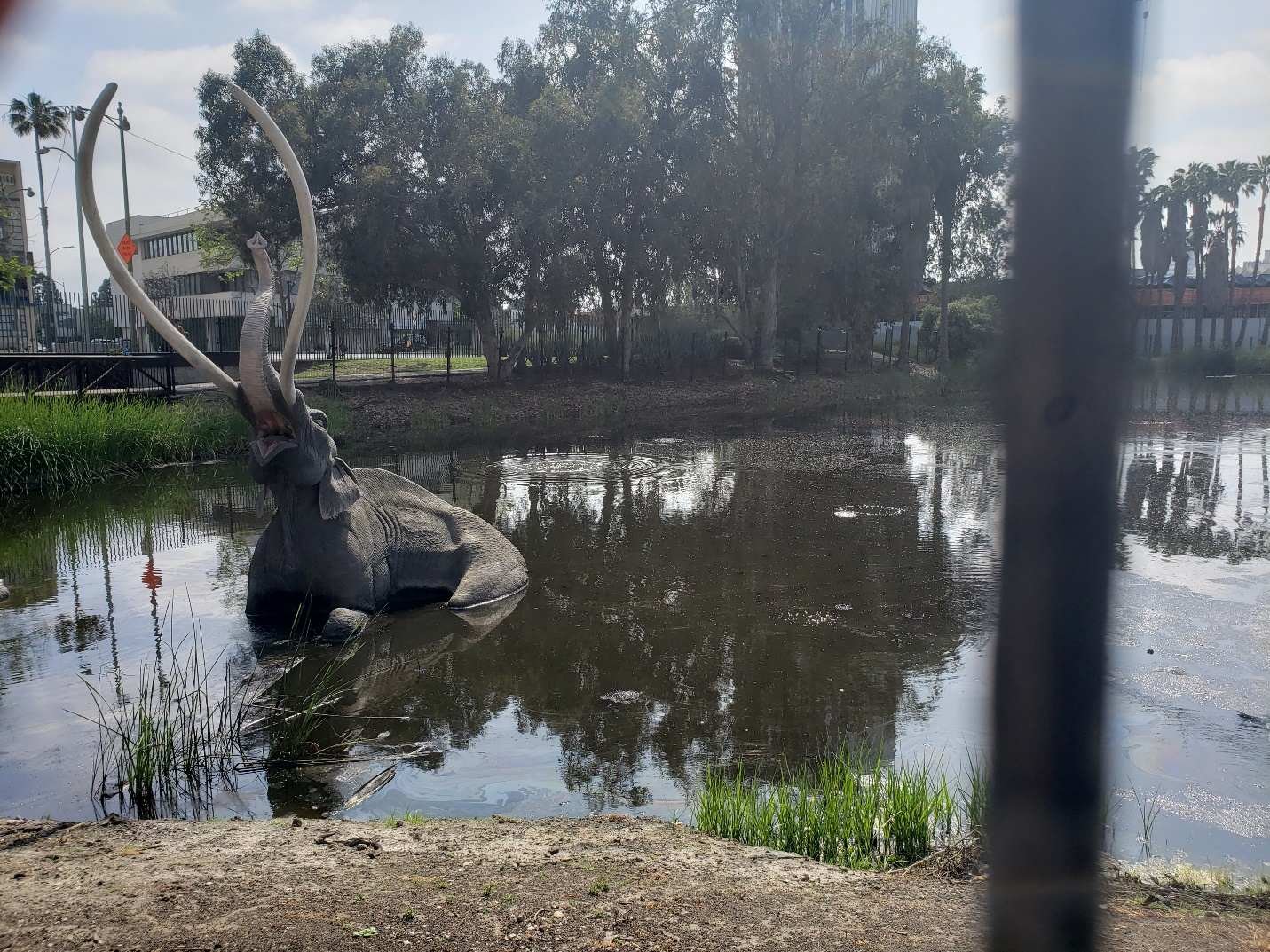La Brea Tar Pits: Where Ice Age Mammoths Walked on Wilshire Boulevard
by Kathy Hrechka, MSDC member and editor of The Mineral Mite

One of my bucket list destinations was recently checked off – having an adventure to the famous La Brea Tar Pits with my husband Ken. On our 12-mile drive from LAX to the La Brea area on Wilshire Boulevard, we passed more than 20 working oil pumps among the residential neighborhoods. That was my indicator we were close to our destination.
We toured the George C. Page Museum and Tar Pits, witnessing larger-than-life, reconstructed Ice Age fossil mammoths, mastodons, camels, sloths, wolves, saber toothed cats, and a fossil lab. Most featured bone structures were more than 80% original. We learned that the La Brea Tar Pits is an active paleontological research site despite being in the middle of heavily urbanized Los Angeles, California. The pits contain fossilized remains of millions of plants and animals dating between 50,000 and 100,000 years ago.
A unique combination of complex geologic events is responsible for the rich accumulations of fossils found at the tar pits. Oil formed, tectonic activity forced it to the surface, and sediments were deposited. Originally the pools were composed of crude oil that originated below Earth’s surface. The oil is a mixture of heteroatom (i.e., not hydrogen or carbon) compounds, hydrocarbons, metals, and inorganic compounds.
In the early 1900s, when dozens of wells pumped oil out of the ground in the area, workers dug 96 pits looking for fossils and removed over one million fossils. The excavation work continues to this day and the La Brea Tar Pits Museum now houses nearly five million fossils.
For over a century, researchers at La Brea Tar Pits and Museum have unearthed the world’s most complete record of what life was like at the end of the Ice Age. So how did different types of fossils end up in the tar pits together? For thousands of years, crude oil has been naturally rising up to the surface forming shallow puddles of sticky goo called asphalt seeps. It was easy for animals to get trapped in the sticky goo. Tar pits were created by excavating ancient asphalt seeps.
Besides the museum, we also enjoyed the famous tar pits outdoors, noting methane gas bubbling up and creating circular rings as the gas escaped from the tar pits. It was fun to guess the locations of future gas bubbles as the pit was quite active, continuously belching gas. Outdoors, fossil excavations continue at locations referred to as Pits 91 and 23. We were not able to observe researchers and volunteers actively working at Pit 91 because the gates were closed to visitors. Pit 23 contained 23 crates of excavated material available for current and future study.
It was amazing to witness such a cool natural phenomenon from the Ice Age in the middle of 21st-century Los Angeles. Here are some photos from the museum with captions. I hope these images from the site and museum will inspire you to visit.



The Columbian mammoths were the most common mammoth species in North America, standing twelve feet tall, weighing 17,000 pounds. Mammoths, mastodons, and their living cousins, elephants belong to a group of mammals called proboscideans. The name comes from the proboscis, or trunk, a feature many of these animals share.
The first proboscideans appeared in Africa about 55 million years, ago and over many generations evolved into more than 150 different species spread around the globe. Discoveries at La Brea Tar Pits show that some of their descendants, Columbian mammoths and American mastodons, were in the Los Angeles Basin 50,000 years ago.






Every fossil in this lab was excavated right outside at Project 23. The name refers to the 23 crates of fossils to clean and archive that came from the excavation site for a new art museum next door to the La Brea Museum.


In 2008, excavation for a neighboring art museum unearthed 23 6’ x 6’ x 6’ blocks of Ice Age fossils. They were donated for continued research at La Brea, referred to as Project 23. The millions of new fossils from Project 23 are helping to reconstruct the environment of the Ice Age of Los Angeles. New finds include bones of saber-toothed kittens, an American mastodon baby, and young horses and camels.



The information provided in this article is reproduced from exhibits in the museum. All photographs are by Kathy Hrechka.
